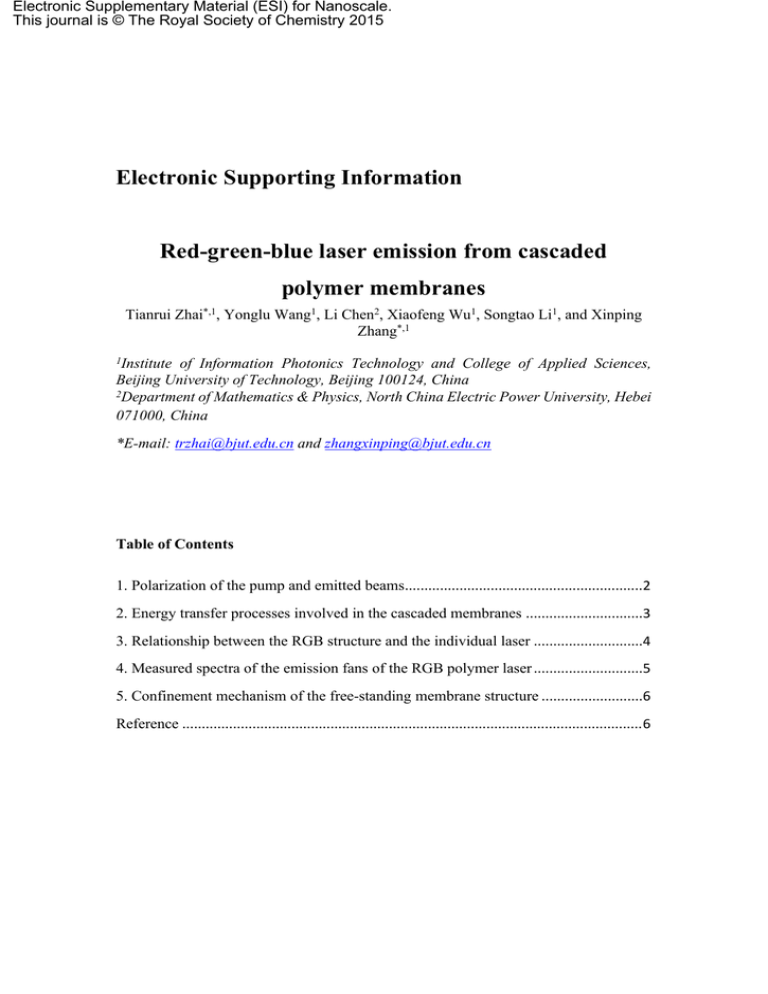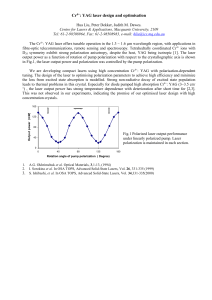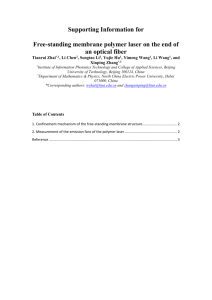Electronic Supporting Information Red-green
advertisement

Electronic Supplementary Material (ESI) for Nanoscale. This journal is © The Royal Society of Chemistry 2015 Electronic Supporting Information Red-green-blue laser emission from cascaded polymer membranes Tianrui Zhai*,1, Yonglu Wang1, Li Chen2, Xiaofeng Wu1, Songtao Li1, and Xinping Zhang*,1 1Institute of Information Photonics Technology and College of Applied Sciences, Beijing University of Technology, Beijing 100124, China 2Department of Mathematics & Physics, North China Electric Power University, Hebei 071000, China *E-mail: trzhai@bjut.edu.cn and zhangxinping@bjut.edu.cn Table of Contents 1. Polarization of the pump and emitted beams.............................................................2 2. Energy transfer processes involved in the cascaded membranes ..............................3 3. Relationship between the RGB structure and the individual laser ............................4 4. Measured spectra of the emission fans of the RGB polymer laser ............................5 5. Confinement mechanism of the free-standing membrane structure ..........................6 Reference ......................................................................................................................6 1. Polarization of the pump and emitted beams The polarization of the pump beam influences the efficiency of the laser emission. And the polarization of the emitted beam is parallel to the grating direction of the cavity. 1 Polarization of the pump ○ Figure S1 shows the emission intensity of the polymer laser as a function of the polarization of the pump. β is the angle between the polarization direction of the pump and the grating direction as shown in the inset in Fig. S1. It can be seen that the best performance (maximum emission intensity) of the polymer laser can be obtained by adjusting the polarization of the pump beam along the grating direction (β=0) of the DFB cavity. Figure S1. Emission intensity of a 1D polymer laser as a function of the polarization of the pump. β is the angle between the polarization direction of the pump and the grating direction in the inset. When a linear polarization beam is used as the pump, only one DFB cavity can achieve the best performance as shown in Fig. S2(a)-(c). It attributes that the grating direction is parallel to the polarization direction of the pump. The shape of the laser pattern is defined by the Bragg diffraction of the 1D grating structures. The white arrows indicate the polarization direction of the pump. Figure S2. The polarization direction of the pump beam is parallel to the grating direction of the (a) B- DFB cavity, (b) G-DFB cavity, and (c) R-DFB cavity, respectively. The white arrows indicate the polarization direction of the pump. (d) Photograph of laser spots from an operating RGB polymer laser pumped by a circular polarization light. In the experiment, a circular polarized light is employed as the pump to achieve simultaneously the best performance of three DFB cavities as shown in Fig. S2(d). 2 Polarization of the emitted beam ○ A strongly polarized emission paralleling to the grating lines is observed as shown in Fig. S3. The blue, green, and red curves in Fig. S3(b) present the output intensity of the B-, G-, and R-DFB cavity, respectively, which are measured using a spectrometer (Maya 2000 Pro, Ocean Optics) with changing the angle φ in Fig. S3(a). Figure S3. (a) Enlarged view of the laser spot. ①, ②, and ③ identify the emission wavelengths of the B-, G-, and R-DFB cavity, respectively. The white solid line denotes the polarization direction of the polarizer. φ is the angle between the polarization direction of the polarizer and the lasing line ①. (b) The measured spectrum of the polarization direction of the output beam of the RGB polymer laser. 2. Energy transfer processes involved in the cascaded membranes The energy transfer process plays an important role in the emission performances of the RGB polymer lasers. Figure S4(a) shows the absorption and PL spectra of PFO, F8BT, and MDMO-PPV, respectively. Note that the absorption spectrum of MDMOPPV overlaps the PL spectra of PFO and F8BT, and the absorption spectrum of F8BT overlaps the PL spectrum of PFO. 1 The energy transfer at the interface of the membranes ○ The FÖrster resonance energy transfer (FRET) may exist at the interface of the membranes. So, the FRET from PFO to F8BT and MDMO-PPV or from F8BT to MDMO-PPV may occur when the distance between two kinds of polymer molecules is within the FÖrster radius.S3 The FRET can be evaluated in a quantitative way as reported in Ref. [S1]. A variable J is introduced to depict the FRET, which represents the percentage of the overlap between the spectra of two polymer materials. ∞ 𝐽= ∫𝑓 (𝜆)𝜀 (𝜆)𝜆 𝑑𝜆 4 𝐷 0 𝐴 (1) where 𝑓𝐷(𝜆) is the normalized spectral distribution of fluorescence, 𝜀𝐴(𝜆) molar extinction coefficient. In our experiment, the J of FRET is found to be 76.6% between PFO and F8BT, 80.4% between PFO and MDMO-PPV, and 32.5% between F8BT and MDMO-PPV, respectively. Considering that the distance between the polymer membranes is much larger than the FÖrster radius as shown in Fig. S4(b), the FRET process is negligible. 2 The energy transfer between the membranes ○ In order to reduce the negative effect of the energy transfer from PFO to F8BT and MDMO-PPV and that from F8BT to MDMO-PPV, the R-, G-, B-DFB cavities are stacked in turn and pumped from the side of the R-DFB cavity, as shown in the inset in Fig. S4. For the surface-emitting lasing from the side of the B-DFB cavity, the cascaded energy transfer of the stacked structure is weak. For this configuration, the positive effect of the energy transfer can be utilized. The backward emission of PFO excites F8BT and MDMO-PPV. The backward emission of F8BT excites MDMO-PPV. These energy transfer process can improve the performance of the RGB polymer laser. The ratios of the energy transfer 𝑅 among three polymer membranes can be evaluated by a simple model as follows: 1 𝑅 = 𝑓𝐷(𝜆)𝜀𝐴(𝜆)𝜆 2 (2) where 𝑓𝐷(𝜆) is the normalized spectral distribution of fluorescence, 𝜀𝐴(𝜆) molar extinction coefficient, 𝜆 emission wavelength. The energy transfer is found to be 30.4% between PFO and F8BT at 448 nm, 24.7% between PFO and MDMO-PPV at 448 nm, and 8.0% between F8BT and MDMO-PPV at 566 nm, respectively. The energy transfer between the membranes is dominant in the cascaded membrane device. Figure S4. (a) Absorption and PL spectra of PFO, F8BT, and MDMO-PPV, respectively. The inset shows schematic of the cascaded polymer membrane laser. (b) SEM image of the cascading membranes. 3. Relationship between the RGB structure and the individual laser The energy transfer process leads to the difference between the RGB structure and the individual laser. In the experiment, the RGB laser device is carefully designed to reduce the negative effect of the energy transfer process as shown in Fig. S4. 1 Threshold ○ The absorption of a single polymer membrane is weak. The absorption of the stacked structure is much stronger than that of individual cavities. Thus, the energy of the pump can be absorbed more efficiently by a stacked structure. The threshold of the stacked structure (29 μJ/cm2) is decided by the maximum threshold of three components (27 μJ/cm2, 14 μJ/cm2, and 29 μJ/cm2) without considering the energy transfer at the polymer interfaces. 2 Pump slope efficiency ○ From Fig. 3(e)-(h), it can be seen that the pump slope efficiency of the RGB structure is slightly different from that of the individual laser. It is decided by the subtle balance between the interface reflectivity and the energy transfer among PFO, F8BT and MDMO-PPV. 4. Measured spectra of the emission fans of the RGB polymer laser In the experiment, a lens with a diameter of 5 mm (optical fiber collimating lens) is used to collect the laser emission, which is mounted on the fiber end face as shown in the inset in Fig. S5(b). The emission spectra shown in Fig. 3(d) can be obtained by placing the fiber on the site ○a in Fig. S5(a). The variation of emission spectra is demonstrated in Fig. S5(b) when the fiber is moved to a different position (○b ,○c ,○d , or ○e ). It can be seen that the relative intensity and the wavelength change for different positions. The wavelength shift of polymer lasers has been reported, which is named "emission fans" in Ref. [S2]. Figure S5. (a) Photographs of laser spots from an operating RGB polymer laser. (b) Emission spectra measurements on five different sites (a, b, c, d, and e in (a)) of the laser spot. The upper inset shows the optical fiber with a collimating lens. The lower inset shows a close-up of the optical fiber collimating lens. Considering that the polymer laser shown in our manuscript is a surface-emitting device, the fiber should be placed on the site ○a . 5. Confinement mechanism of the free-standing membrane structure The refractive index difference between the membrane (~1.7) and air (~1.0) is much bigger than that between the membrane and the glass substrate (~1.5), as shown in Fig. S6. For the structure in Fig. S6(a), some of the radiation will leak out into the glass substrate. However, for the free-standing membrane structure, most of the radiation is effectively confined within the polymer waveguide (membrane) due to the strong reflection at the two membrane/air interfaces. Therefore, a very strong amplification of the radiation through stimulated emission can be achieved by employing this waveguide scheme without a substrate as shown in Fig. S6(b). Figure S6. Schematic illustration of the confinement mechanism of the waveguide scheme (a) with and (b) without a substrate. The black arrows indicate the propagation of the radiation. Reference [S1] T. Xu, M. J. Wei, H. Zhang, Y. Q. Zheng, G. Chen, and B. Wei, “Concentrationdependent, simultaneous multi-wavelength amplified spontaneous emission in organic thin films using Förster resonance energy transfer,” Appl. Phys. Lett. 107, 123301 (2015). [S2] S. Riechel, C. Kallinger, U. Lemmer, J. Feldmann, A. Gombert, V. Wittwer, and U. Scherf, “A nearly diffraction limited surface emitting conjugated polymer laser utilizing a two-dimensional photonic band structure,” Appl. Phys. Lett. 77, 23102312 (2000). [S3] A. A. Shoustikov, Y. You, and M. E. Thompson, “Electroluminescence color tuning by dye doping in organic light-emitting diodes,” IEEE J. Sel. Top. Quantum Electron. 4, 3-13 (1998).



